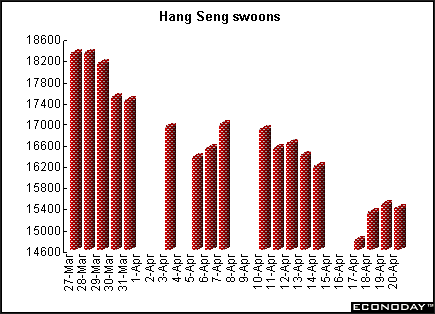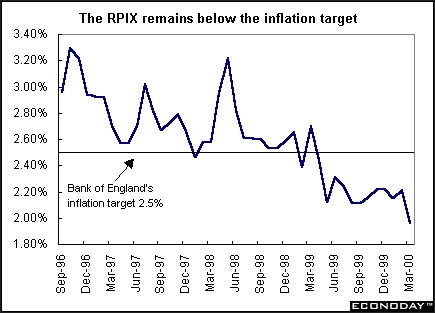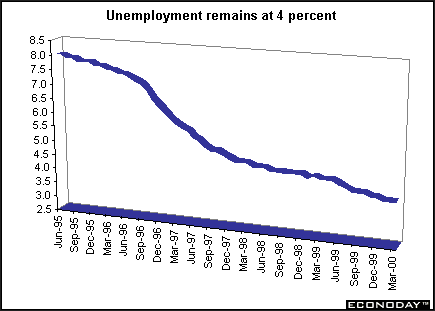| Previous Articles |
|
Overseas markets picked
up the pieces rather warily last week as they assessed the damage from
the previous Friday's dive on U.S. equity markets. European and British
markets already had closed on Friday before the full extent of the damage
to the U.S. markets was known. The London FTSE 100 completed its slide
Monday. Asian markets reacted on Monday with a downward spiral of their
own. However, things picked up for most markets after that in a holiday
shortened trading week, although they never fully recovered all of Monday's
losses. The exception was the Nikkei, which had to deal with domestic
travails as well. On the week, Asian markets and the Frankfurt DAX finished
lower.
Britain
and Europe
Interest rates are again looming on the markets' horizons for the European Monetary Union (EMU), Britain and the United States. The European Central Bank (ECB) will meet Thursday, the Bank of England's monetary policy committee on May 3rd and 4th, and the U.S. Federal Reserve on May 16th. Economic indicators were pretty much ignored even though several major inputs to the Bank of England's policy meeting were released. Most analysts believe that the cost of borrowing in the U.K. will be raised from its current 6 percent level. A noteworthy disappointment was the German Ifo business sentiment index. At week's end activity was relatively light, with many investors staying away from the market before the four day Easter holidays. Although London, Europe and New York markets were shut on Friday, Wall Street is open on Monday and that appeared to deter participants from taking new positions. Thin pre-holiday trading suggested that many market participants left for their long weekend early. The FTSE 100 managed to recoup all of Monday's losses and closed the week up 63 points or 1.02 percent at 6241. Overall, the European markets showed little interday volatility. Market players traded conservatively across the board on Thursday. The markets paid little attention to economic indicators even though the important The DAX edged down 56.88 points or 0.8 percent to close the week at 7178. However, the Paris CAC climbed 168.8 points or 2.78 percent to end the week at 6235. Asia The Nikkei was hit with a double whammy - the U.S. markets took a dive and a restructuring of the Nikkei 225, the benchmark for investors in Japanese stocks, was announced. The component companies are changing for the first time in nearly a decade so that the 225 stocks include more "new Japan" companies following criticism that the index does not reflect changes in the nation's industry. Some of the companies had been left out because of the Nikkei 225's strict admission rules. But the standards were loosened for the first time since October 1991 to include more stocks with high liquidity. The composition of the index will be reviewed once a year, in October. The change takes effect today (April 24).
The Nikkei 225 ended its worst week in almost a decade, shedding 10.68 percent as investors raised money to buy the new index members. Tracker funds sold the 30 stocks that will be replaced along with other stocks to raise money to buy the new index members. The volatility reflected index investors' sales of stocks set to be excluded from the average. On the week, the Nikkei lost 2,182 points to close at 18,252.68. Hong Kong's Hang Seng sank 1380.39 points to 14,762.37 on Monday, a new low for the year 2000 and its biggest decline since the Asian financial crisis. Banks shares also dropped on concern the U.S. Federal Reserve may raise interest rates to dampen inflation after the larger than expected gain in the consumer price index. Hong Kong is expected to mirror any U.S. interest rate rise as its currency is pegged to the dollar. However, the index rebounded Tuesday. In a holiday shortened week, the Hang Seng managed to recoup less than half its Monday losses to close down 775.62 points or 4.8 percent at 15,367.14.
Currencies
The euro was under continued pressure after U.S. equity markets posted sizable gains, relieving concerns that Monday's Wall Street recovery would be short lived. Longer term sentiment on the euro remained negative as the single currency has failed to mount a sustained rally despite the troubles for U.S. stocks. With central bank meetings on the horizon, policy making interest rates in both the United States and the United Kingdom are at 6 percent. After the unexpected jump in U.S. inflation, analysts expect that the Fed to increase rates faster than the Bank of England. By contrast, British price increases were at a record low, and below the central bank's target of 2.5 percent. But other reports showed average pay and retail sales rising, and mortgage lending by banks climbing to a record high. (see below) Those figures left intact expectations that the Bank of England will raise rates at least once more in the months ahead as a pre-emptive strike against inflation. The dollar traded near a one week high against the yen as the recovery in U.S. stocks increased demand for dollars to purchase shares. The dollar's ascent was restrained on expectations Japanese exporters will sell dollars to bring profits back home. The foreign exchange markets were also wary of possible Bank of Japan intervention. The bank has used holiday thin markets in the past to get the most out of its actions.
Indicator Scoreboard March retail price index (RPI) rose by 0.5 percent on the month and was up 2.6 percent on the year (from 2.3 percent last month). Retail prices excluding mortgage interest payments, the Bank of England's main inflation gauge, rose 0.4 percent on the month and 2.0 percent on the year. This is the lowest rate since October 1994 and has not been lower since comparable records began in 1975. This is the twelfth month that the RPIX has been below the Bank of England's 2.5 percent inflation target.
February earnings rose 5.5 percent when compared with a year ago. Increased earnings growth was evident in all sectors except manufacturing. Earnings growth in the three months to February was 6.0 percent higher than in the same three months a year ago. This was the highest since July 1992. Earnings growth remains above the 4.5 percent threshold that the Bank of England considers compatible with its inflation target.
March claimant count unemployment rate was 4.0 percent for the third straight month and was the lowest since January 1980. International Labor Organization (ILO) unemployment in the three months to February fell to 5.8 percent from 5.9 percent recorded in the three months to January. The government prefers the ILO measure which includes people looking for work but not eligible for benefits.
March seasonally adjusted retail sales volumes rose 0.5 percent on the month and 4.6 percent on the year. In the three months to March, sales were up 1.5 percent on the previous three months and up 5.1 percent on the same three months a year earlier. Sales were particularly strong in the household goods sector, reflecting the strength of the housing market. Sales in this sector rose by 2.3 percent on the month in March and were up 10.9 percent on the year.
EMU - March harmonized index of consumer prices (HICP) climbed to 2.1 percent when compared with last year. While the HICP annual rate now exceeds the European Central Bank's 2.0 percent limit for price stability for the first time, the ECB has made it clear that it expects the rate to decline in coming months and average less than 2 percent for the full year. The March price increase was mainly due to a surge in energy prices, which were up 2.4 percent on the month and 15.3 percent on the year. Core inflation - excluding energy, food, alcohol and tobacco - posted a modest monthly gain of 0.2 percent on the month and 1.1 percent on the year. Eight EMU members reported annual inflation rates above 2 percent - Ireland, Spain, Luxembourg, Italy, Finland, Germany, Belgium and Austria.
Germany - March Ifo Institute's west German business sentiment index posted an unexpected decline, its first since April 1999. The slip was due to slight declines in both sentiment on current conditions and on business expectations. East Germany's business sentiment also fell. However, in east Germany only the current conditions index declined while business expectations rose slightly.
March wholesale prices rose 0.8 and were up 5.7 percent when compared with last year. Excluding combustibles and motor fuels, wholesale prices were up 2.3 percent on the year. Combustibles (crude oil, gas and coal) and motor fuels alone were up 5.4 percent in March and 49.7 percent on the year. Italy - January seasonally adjusted industrial orders fell 8.8 percent on the month, after a drop of 1.2 percent in December. Seasonally adjusted domestic orders fell 6.6 percent on the month, while foreign orders dropped 12.2 percent. When compared with last year, January unadjusted industrial orders fell 4.6 percent after a 15.8 percent rise in December, posting their sharpest fall since February 1999. France - February seasonally adjusted merchandise trade surplus recovered as exports continued higher while imports contracted, especially in the energy sector. February exports rose 0.5 percent boosted by 14 Airbus sales. Imports fell back 0.7 percent despite a rise in consumer goods imports and continuing strong auto imports. The energy deficit dropped to E1.458 billion from E1.851 billion in January. February seasonally and workday adjusted manufacturing output soared 1.5 percent. When compared with last year, output jumped 5.2 percent. The data base year was updated from 1990 to 1995 and coverage was extended to include micro-computing equipment, handicrafts and water distribution. Spain - February workday adjusted industrial production rose a strong 8.3 percent when compared with last year. January adjusted output was revised up to 3.1 percent from the 2.5 percent gain originally reported. Asia Unemployment rate edged down to a 16 month low in the three months through March. The city's provisional, seasonally adjusted unemployment rate for the latest three months was 5.6 percent, down from 5.7 percent in the three months through February. New jobs in information technology and related fields helped slice the unemployment rate. Korea - March unemployment rate fell to 4.7 percent in March from 5.3 percent a month earlier. This was its biggest decline in six months as the construction and agriculture industries stepped up hiring and startup companies generated more jobs. The seasonally adjusted rate fell to 4.1 percent from 4.4 percent in February, the biggest drop since September. Australia - First quarter manufacturing output prices rose 1.8 percent on the quarter and 5.6 percent when compared with last year. The price increases were pervasive. Americas
February manufacturers' shipments declined 1.8 percent but were still 10.3 percent higher than a year ago. Manufacturers' shipments decreased in 16 of the 22 major groups in February, representing 67.2 percent of the total value of shipments. Manufacturers' backlog of unfilled orders dropped 0.7 percent. Manufacturers' inventories rose 1.5 percent in February bringing the inventory to shipments ratio to 1.31 in February. February merchandise trade surplus slipped to C$4 billion from January's record C$4.5 billion, as exports fell 2.6 percent and imports decreased 1.2 percent. Most of February's declines were in the automotive sector, which saw a temporary slowdown at some Canadian plants. Analysts said the C$4 billion trade surplus, combined with the C$4.5 billion surplus in January, sets the stage for a current account surplus in the first quarter of the year.
BOTTOM LINE Looking Ahead: April
24 to April 28, 2000
|
||||||||||||||||||||||||||||||||||||||||||||||||||||||||||||||||||||||||||||||||||||||||||||||||||||||||||||||||||||||||||||||||||||||||||||||||||||||||||||||||||||||||||||||||||||||||||||||||||||||||||||||||||||||||||||||||












